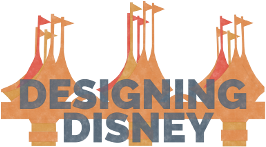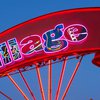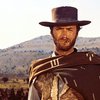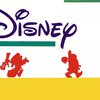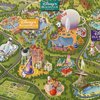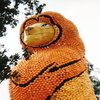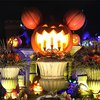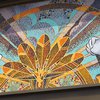Euro Disney Resort Site Selection & Master Plan
In a previous ‘Designing Disney’ series, it was shown that the early nineties corporate design of Disneyland Paris was matched to that of Walt Disney World. This and next week’s articles discuss the genesis of Euro Disney’s master plan while assuming that Disney’s European project was designed to be a concentrated version of its greater Floridian sibling.

Selection of the site
Disneyland Paris has been built in the new town of Marne-la-Vallée, 25 miles east of Paris. Marne-la-Vallée is one of the largest agglomerations in the Ile-de-France region. It extends over 3 departments (Seine-et-Marne, Seine-Saint-Denis, Val de Marne) and includes 27 municipalities divided into 4 urban districts (Porte de Paris, le Val Maubuée, le Val de Bussy, le Val d’Europe).

The Resort is part of the Val d’Europe urban district and is located close to the villages Bailly-Romainvilliers, Chessy, Coupvray, Magny-le-Hongre and Serris.

The site was selected by Disney based on a report written by a consulting firm called “Bourdais Consultants Associés”. The document was titled “European Disneyland – Greater Paris Region Site Screening” and its cover page included the following statement:
“At the request of Walt Disney Productions, Bourdais Consultants Associes compiled in this document technical data dealing with sites located in [or close to] the Ile de France primary market as defined in the site selection criteria”.

The report contained several maps and information about various sites close to Paris, which were considered by the consulting firm as suitable for what Disney was planning to build. These sites were located in the following villages:
- Bailly-Romainvilliers (Ile-de-France)
- St-Pierre du Perray (Ile-de-France)
- Combs-la-Ville (Ile-de-France)
- Tournan en Brie (Les Boulays - Ile-de-France)
- Coulommiers (Limosin - Les Bordes - Ile-de-France)
- Ormoy Villers (Le Bois du Roi - Oise, Picardie)
- Creil (Foret de la Haute Pommeraie - Oise, Picardie)
- Roye / Saint Mard (Somme, Picardie)
- Sissonne (Aisne, Picardie)
- Germaine (Marne, Champagne-Ardenne)
- Joigny (Yonne, Bourgogne)
In 1985, the parcel of 2,230 hectares (5510 acres, more than one-fifth of the surface area of Paris) near Bailly-Romainvilliers was selected. The accessibility of this site was rated as excellent, given the proximity to the A4 motorway and the fact that “the Regional Plan calls for the extension of the RER line [from Torcy] to Serris”.


The “Development Outlook” for a theme park with hotels and other accommodations was excellent. The site was considered “good” for becoming an international conference center. And “Bourdais Consultants Associés” also noted that the parcel offered the “opportunity for Walt Disney Productions to built a new people mover”.
One company was closely involved in selecting the site: “PBR Inc.” from Irvine, California.
The master plan for the selected site
The site plan of the Euro Disney Resort was created by “PBR Inc.”, a development consulting firm, whose “specialty is entitling and subdividing large land parcels within the framework of large master planned communities”.

They partnered with “Sasaki Associates Inc.”, a landscape design firm (from Santa Ana, California) who devised a street-lighting and tree-planting scheme to dress up the main boulevards running through the Resort.
About 85 PBR staff members worked for 8 years on the Euro Disney project. In this period, several site plans were developed and submitted for consideration by Disney. The first layouts of the site plan were made public in March 1987.
The first generation of master plans
The first master plans already resemble quite well to what was ultimately built. The basic framework is in place: a huge circular boulevard. This road is of central importance to the plan. It acts like a bypass, which enables access to all parts of the Euro Disney Resort.

Inside the circle, the key elements of the project were located: the Magic Kingdom, a second theme park (“Euro EPCOT” according to “Le Figaro”), hotels, a multi-use urban center, an office & industrial park and a regional shopping center. Outside the circle, PBR suggested housing subdivisions, time-share developments, golf courses, camping grounds and more offices.

Taking into account the fact that Disney had the intention to built four theme parks, roads were planned so that huge parcels of empty land were created, large enough to accommodate future developments.
With this layout, Disney clearly wanted to make the most of the site and to try to limit parasite developments of hotels and attractions. The parks are as far away as possible from the A4 motorway access. And the huge circular boulevard has been created with the biggest diameter possible within the site acquired to serve as a physical boundary between Disney and its surroundings / competitors.

The main difference between the final plan and these two versions is the zoning of its center. The plans shown above propose a multi-use urban center in the heart of the Euro Disney Resort, located vis-à-vis the Disneyland Hotel. The zone would feature restaurants, shops, offices, a conventions center and hotel and apartments that would have been higher than the largest structure in the Magic Kingdom.
The second generation of master plans
The third, fourth and fifth master plan are very close to what was built so far and what will be built in the future. Compared to the older master plans, the mixed-use urban center has been shifted to the southeast quadrants of the site. This allowed PBR to locate a good deal of the hotels and the “Festival Disney” entertainment center much closer to the gates of the theme parks.

Water is an important aspect of these plans. Lakes and rivers connect the sites for the hotels. In the first second generation master plan, there is a continuous band of water all the way from the Resort hub to the golf course. The third second generation plan shows what was actually built.


This article was written by one of our best Disney friends Will. His fascination and appreciation for Disney started with the opening of Euro Disneyland in 1992. Coming from an American Cultural Studies background, Will today is most interested in the original concept of the Euro Disney Resort and the cultural messages that the Walt Disney Company wanted to convey about the United States back in the late 1980s. To Will, the 1992 Euro Disney complex is an outstanding example of postmodern architecture and culture, which should be maintained in and reconstructed to its original state as closely as possible. These concerns and interests lead the author to follow and support 'Designing Disney'. We would like to sincerely thank Will for the efforts that he has made in writing this marvelous article!
Credits
Photos Bailly-Romainvilliers: Town Council of Bailly-Romainvilliers
